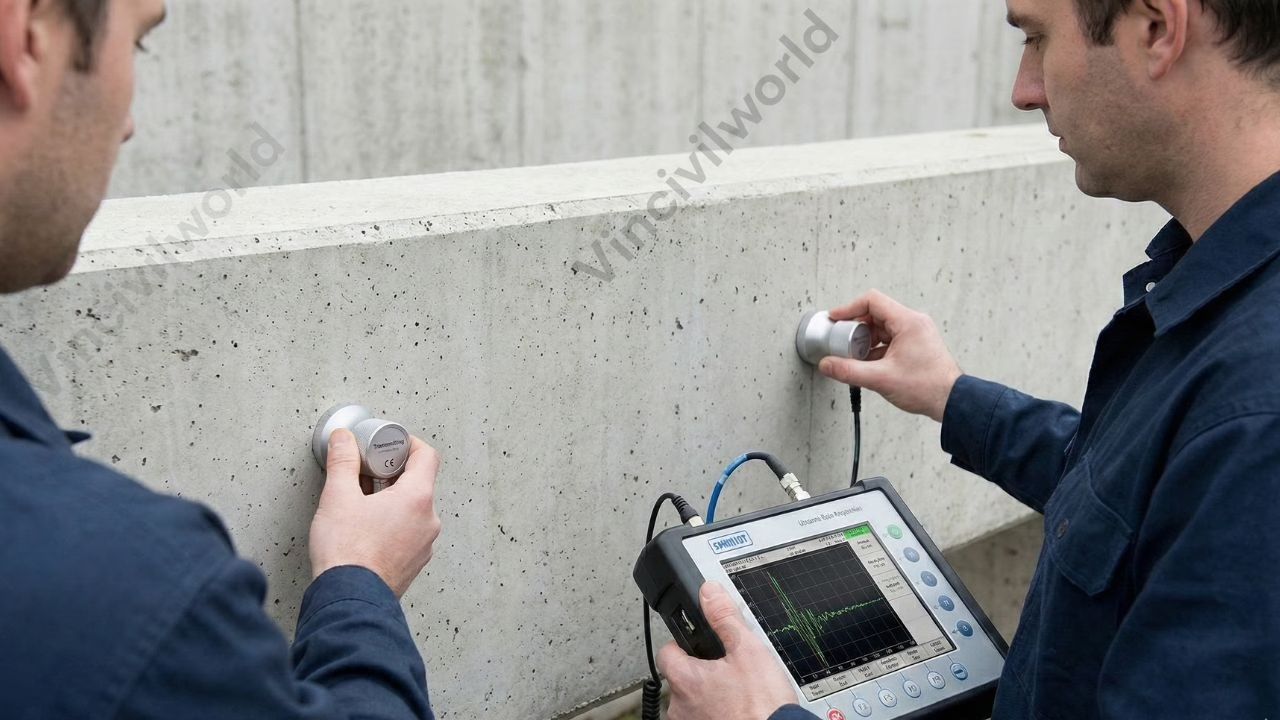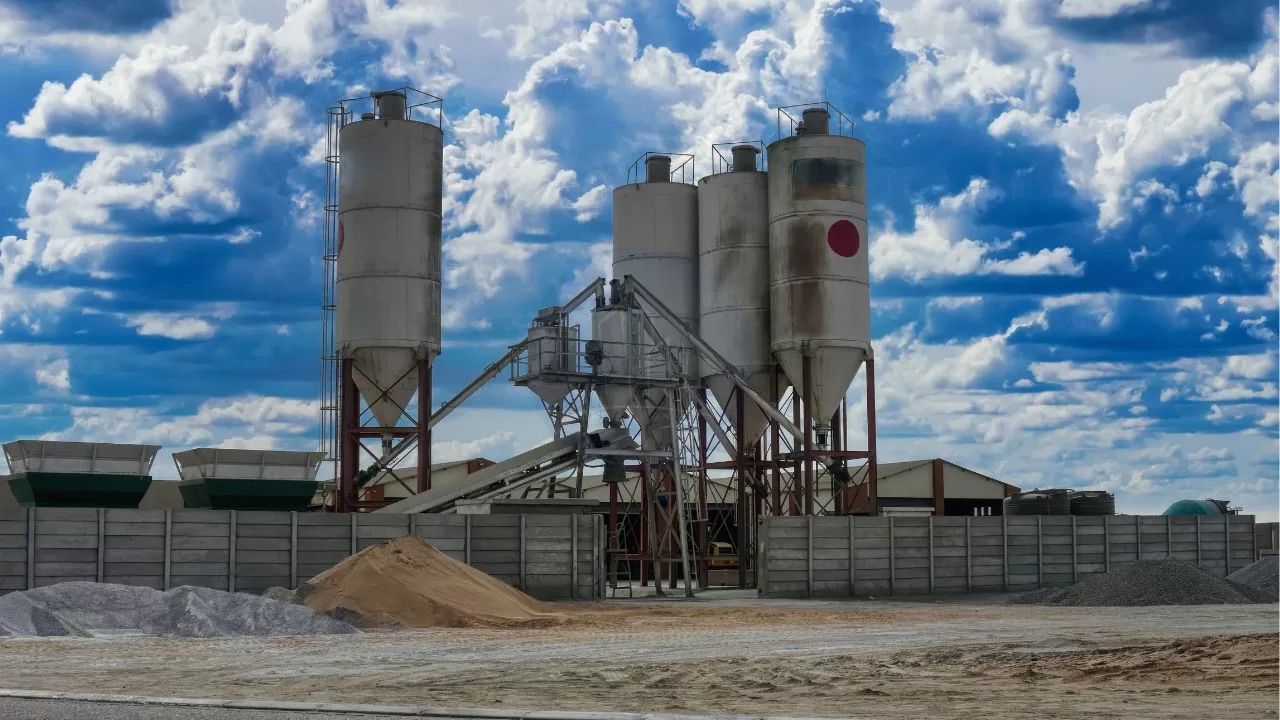Shotcrete is a method of placing concrete where concrete/mortar is sprayed at high velocity to an overhead or vertical surface. Concrete is conventionally placed on the ground or to the formwork and compacted using appropriate vibration methods.
What is shotcrete?
Shotcrete is a wet or dry mix of mortar/concrete sprayed to a vertical or overhead surface with high velocity. The mortar/concrete mix is conveyed through a hose and sprayed with a nozzle with high velocity. The force imparted by this application process consolidates the concrete/mortar resulting in an excellent bonding with almost all substrates. Shotcrete is also called sprayed concrete. The pressure will be maintained to around 20-30 N/cm2.
When mentioning about shotcrete another term which is commonly used is gunite or guniting.

What is gunite or guniting ?
Guniting and shotcrete are more or less the same. The difference between shotcrete and gunite is basically in the method of spraying and mixing ingredients.
Shotcrete spraying is accomplished through either of the following process.
a) Dry mix process
b) Wet mix process
The dry mix process is called gunite or guniting
In Gunite / dry mix process the dry materials are premixed and placed in a hopper. With the help of compressed air, the dry materials are driven to the nozzle. Water gets mixed with the ingredients from a separate source just before going out of the nozzle. The mixed material hit the surface to be applied at a super high velocity through the nozzle.
In the wet-mix process/Shotcrete, the ingredients are premixed with water like conventional concrete and placed in a hopper. Just like the dry-mix process, the wet-mix process uses compressed air to shoot the concrete through a hose. This is also called sprayed concrete were fully mixed concrete or mortar is sprayed through a nozzle.

Both these process are used depending on the area of application and site conditions.
Shotcrete vs Gunite – A comparison
Both of these methods have there pros and cons. The uses are distinguished depending on the area of application and nature of the job.
| GUNITE | SHOTCRETE |
| In the gunite process, we can stop and start the job after some interval, and still, the material will stick on to the old surface due to the high velocity at which the material is applied. | Shotcrete material is premixed and to be consumed within a specified time or else the material strength and qualities will be affected. |
| The applicators get much more work time since the cement mixing is done at the site. With gunite, you can stop and start the application without creating any cold joints. They got super high strength accompanied by low shrinkage. | The joints formed in shotcrete due to any stoppage of work leads to a cold joint and the next layer applied after a certain period behaves as a different layer. A cold joint may develop and cracks may happen. |
| A super-skilled operator is required for gunite. The total quality, consistency, and strength of the gunite depend on the skill of the operator. And the ratio of water, cement sand mix. The nozzle operator controls the application, adjusting water levels as needed to get the right mix consistency. | Highly skilled workers are not needed for a shotcrete application. The crew doesn’t have to be as skilled because the concrete comes already mixed and no need for any mixing or proportioning at the site. It’s easier to add specialised admixtures to the concrete |
| The high water content will ruin the mix and less water content will clog the hose and nozzle. Therefore care should be taken to maintain optimum water content. | You don’t need to add water as it comes premixed with water. Sometimes water is added to improve the consistency of the mix in transit mixtures at site. This reduces the strength of the mix and cause shrinkage cracks. |
| Guniting gives a strong and uniform surface | Shotcrete gives a strong and consistent surface |
| Gunite produces a lot of oversprays called Rebound wastage. These rebound wastage are not to be reused and generate huge wastes. Disposing and housekeeping the area requires extra manpower. | Wastage is less compared to Gunite in case of shotcrete. |
| Guniting is less expensive than shotcrete. Large-sized aggregates are not used in concrete, and mostly it will a cement-sand mix. | Shot Crete is more expensive than gunite and uses aggregate up to 20 mm or as per design mix recommendations. |
| Completion time is slow compared to shotcrete | The shotcrete process is faster than gunite and got higher production rates. |
| Gunite is easier to clean up than shotcrete. The hose is lighter and easier to use Because you add water at the nozzle, the concrete is very fresh when you spray it. | If the hose gets clogged, it can be tough to clear which could be dangerous for the crew and property |
The bottom line is that both gunite and shotcrete have their advantages and disadvantages. The truth is both will produce a high-quality, watertight, durable surface if you do the processes correctly. A super-skilled operator for doing the works improves the quality of the process.
Advantages of shotcrete
Shotcrete-sprayed concrete is increasingly becoming popular because of its extremely economical and flexible application process.
- Shotcrete has got several advantages when compared to conventional concrete. For swimming pools, water retaining structures shotcrete is an ideal choice. They are easier to spray and admixtures can also be included to enhance mix qualities.
- Shotcrete is durable and it imparts more strength to structures.
- The process of application of shotcrete makes the concrete dense and less porous than conventional concrete.
- They help in reducing shrinkage cracks, cold joints and produce an even, nonporous and durable concrete.
- They help in reducing the construction time and reduce valuable time and money incurred as formwork costs and makes the work far more easier.
- Shotcrete/gunite can save money in terms of shuttering, labour costs and can shorten the project delivery schedule.
- Cold joints and areas where shuttering possibility is minimum can also be done using shotcrete methods.
- It is possible to create any shape using shotcrete which is not possible using conventional concrete.

Application of Shotcrete/guniting
Shotcrete is extensively used in a wide range of applications due to there ease and flexibility in placing and capability of producing a dense and non porous concrete surface. They are used for..
- Shotcrete is used for the construction of thin, lightly reinforced sections such as curtain walls.
- Used for shell or folded plate roofs.
- Used for underground structures and tunnels, lining works. For pre-stressed tanks, swimming pools, water retaining structures for treatment plants, etc.
- Shotcrete/gunite is used for repairing deteriorated concrete and retrofitting works.
- Used for structural steel encasing works.
- Shotcrete is used for the formation of canal lining, reservoirs, and repairing of linings.
- They are best suited for applications in underground structures, basement waterproofing works, water retaining structures, deep excavation slope protection, etc.
Disadvantages of Shotcrete/Gunite
- The success of shot crete depends on the skill of the operator.
- Shotcrete cost is higher than conventional concrete.
- Chances of concrete loosing its quality due to delay in spraying or pouring water to increase workability.
- Getting a perfect bond with some surfaces is very difficult.



4 thoughts on “Shotcrete – A total overview||Shotcrete vs Gunite”
Comments are closed.